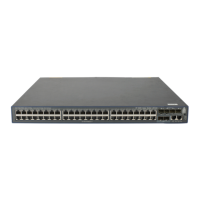33
Step Command Remarks
1. Enter system view.
system-view N/A
2. Enable the trap
function for RADIUS.
radius trap { accounting-server-down |
authentication-error-threshold |
authentication-server-down }
Disabled by default.
Enabling the RADIUS client service
To receive and send RADIUS packets, enable the RADIUS client service on the device. If RADIUS is not
required, disable the RADIUS client service to avoid attacks that exploit RADIUS packets.
To enable the RADIUS client service:
Step Command Remarks
1. Enter system view.
system-view N/A
2. Enable the RADIUS client
service.
radius client enable
Optional.
Enabled by default.
Setting the DSCP value for RADIUS packets
Ste
Command
Remarks
1. Enter system view. system-view N/A
2. Set the DSCP value for IPv4
RADIUS packets.
radius dscp dscp-value
Optional.
The default DSCP value is 0.
3. Set the DSCP value for IPv6
RADIUS packets.
radius ipv6 dscp dscp-value
Optional.
The default DSCP value is 0.
Displaying and maintaining RADIUS
Task Command Remarks
Display the configuration information
of RADIUS schemes.
display radius scheme
[ radius-scheme-name ] [ slot
slot-number ] [ | { begin | exclude |
include } regular-expression ]
Available in any view
Display the statistics for RADIUS
packets.
display radius statistics [ slot
slot-number ] [ | { begin | exclude |
include } regular-expression ]
Available in any view
Display information about buffered
stop-accounting requests for which no
responses have been received.
display stop-accounting-buffer
{ radius-scheme radius-scheme-name |
session-id session-id | time-range
start-time stop-time | user-name
user-name } [ slot slot-number ] [ |
{ begin | exclude | include }
regular-expression ]
Available in any view
Clear RADIUS statistics. reset radius statistics [ slot slot-number ]
Available in user view

